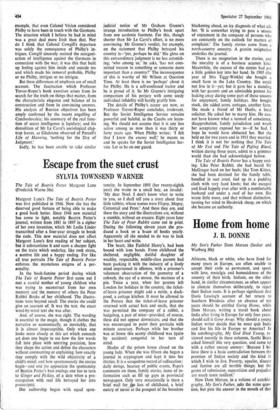Escape from the suet crust
SYLVIA TOWNSEND WARNER
Margaret Lane's The Tale of Beatrix Potter was first published in 1946. Now she has the deserved good fortune of being able to make a good book better. Since 1946 new material has come to light, notably Beatrix Potter's journal, written from 1881 to 1897 in a cipher of her own invention, which Mr Leslie Linder transcribed after a, four-year struggle to break the code. This new material does not affect Margaret Lane's first reading of her subject, but it substantiates it and casts a sharper light on the traits which underlay, like rock strata, a sombre life and a happy ending. For like all true portraits The Tale of Beatrix Potter enforces the mysterious enigma of a per- sonality.
In the book-famine period during which The Tale of Beatrix Potter first came out I met a careful mother of young children who was trying to reconstruct from her own memory and the memory of others the Peter Rabbit Books of her childhood. The illustra- tions were beyond recall. The stories she could give an account of. It was the text, the exact word-by-word text she was after.
And, of course, she was right. The wording is essential to the magic, though it clothes the narrative so economically, so inevitably, that it is almost imperceptible. Only when one looks more closely at this art which conceals art does one begin to see how the few words fall into place with unerring precision, how they shape the action and define the characters without commenting or explaining, how exactly they comply with the wild objectivity of a child's mind; and how spontaneously the stories begin—and end (to appreciate the spontaneity of Beatrix Potter's best endings one has to turn to Ginger and Pickles, of a date when a pre- occupation with real life betrayed her into postscripts).
Her authorship began with equal spon- taneity. In September 1893 (her twenty-eighth year) she wrote to a small boy, an invalid: 'My dear Noel. I don't know what to write to you, so I shall tell you a story about four little rabbits, whose names were Flopsy, Mopsy, Cottontail and Peter.' And there they are, and there the story and the illustrations are, without a stumble, without an erasure. Eight years later The Tale of Peter Rabbit came out in print. During the following eleven years she pro- duced a book or a brace of books yearly. Apparently all she needed to do was to look in her heart and write.
The heart, like Faithful Henry's, had been bound with iron bands. From childhood the sheltered, negligible, dutiful daughter of wealthy, respectable, middle-class parents had been packing it with the industry of a lively mind imprisoned in idleness, with a prisoner's vehement observation of the geometry of a cobweb, the eye of a mouse, the neatness of a pin. Twice a year, when her parents left London for holidays in the country, the ticket- of-leave prisoner might add a nettle, a duck- pond, a cottage kitchen. It must be allowed to the Potters that the ticket-of-leave prisoner returned with actual bats and snails, that she was permitted the company of a rabbit, a hedgehog, a pair of mice—provided, of course, these did not appear downstairs; and that she was encouraged to paint their portraits with minute accuracy. Perhaps -while her brother was at home this scanty childhood was (quite by accident) congenial to her turn of mind.
Shades of the prison house closed on the young lady. When she was fifteen she began a journal in cryptogram and kept it into her thirties. It is a scrupulous record of suffocation : daily doings, hearsay of public events, Papa's comments on them, family stories, items of in- formation such as fill up gaps in provincial newspapers. Only very occasionally is there a brief wail forAlle loss of childhood, a brief outcry of terror at the prospect of the boredom blackening ahead, an icy diagnosis of what ails her. 'It is somewhat trying to pass a season of enjoyment in the company of persons who are constantly on the outlook for matters of complaint.' The family stories came from a north-country ancestry. A granite resignation underlies the journal.
There is no resignation in the stories, and the morality is of a business acumen kind. Meanwhile, the success of the stories had put a little golden key into her hand. In 1905 (the year of Mrs Tiggy-Winkle) she bought a small farm in the Lake Country. She could not live in it—yet; but it gave her a standing with her parents and an admissible pretext for leaking away during some part of those seasons for enjoyment, family holidays. She bought stock, she added acres, cottages, another farm. She made a friend of Mr Heelis, a local solicitor. He asked her to marry him. He can- not have known what a turmoil of conscience, disapprobation, family jurisdiction and wrath her acceptance exposed her to—if he had, I hope he would have abducted her. But she held on for two years and in 1913 they married. I think it is not for nothing that The Tale of Mr Tod and The -Tale of Pigling Bland, written during those years, admit to a grimmer world than she had acknowledged before.
The Tale of Beatrix Potter has a happy end- ing. Like Peter Rabbit, she had heard Mr McGregor hard on her heels; like Torn Kitten, she had been destined for the family table, bundled in suet crust, tied up in a pudding cloth with very hard knots; but she escaped and lived happily ever after with a t omfortable husband and under a roof of her own. She wrote little more, and that without distinction, turning her mind to Herdwick sheep, on which she became an authority.










































 Previous page
Previous page